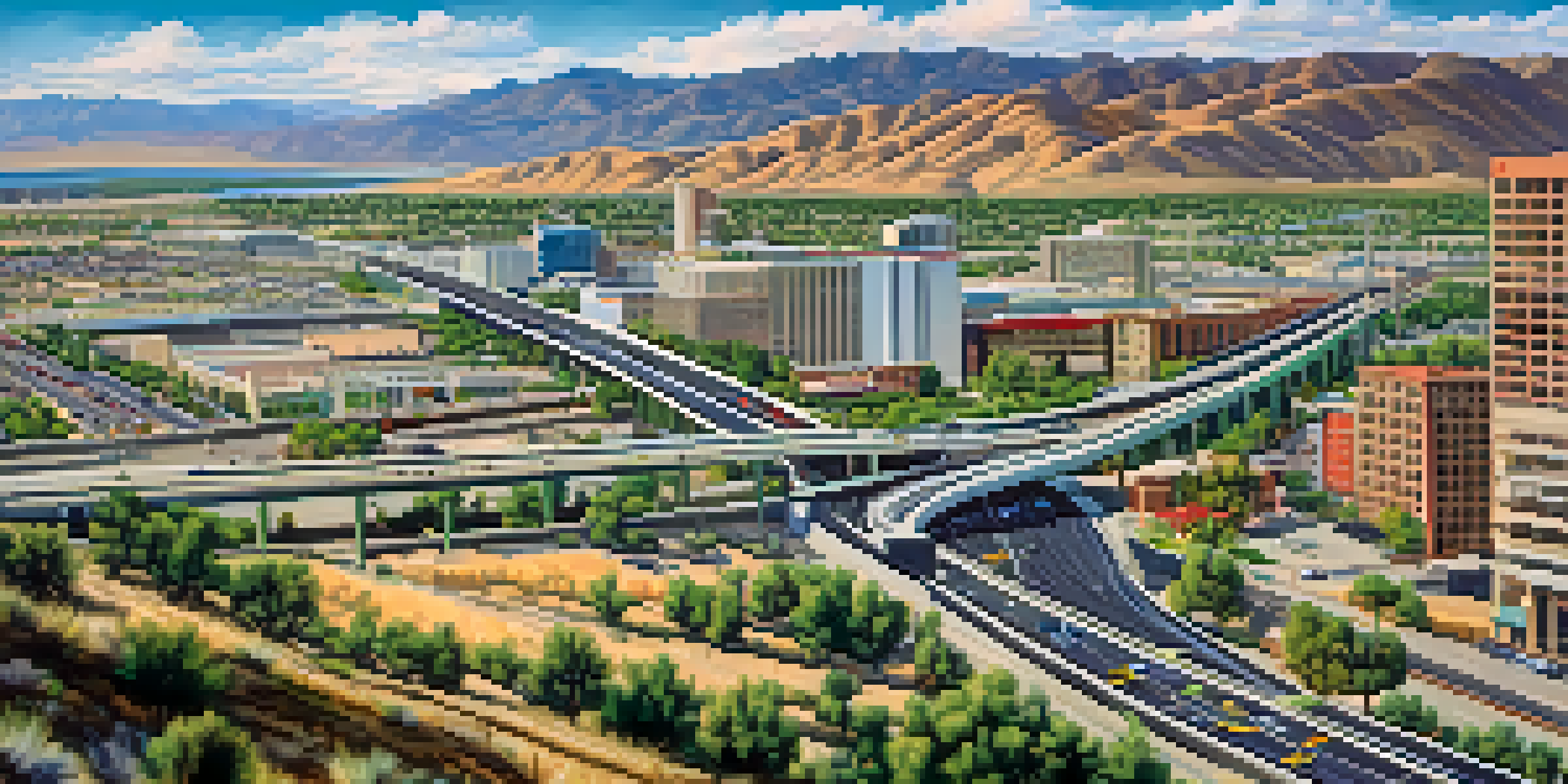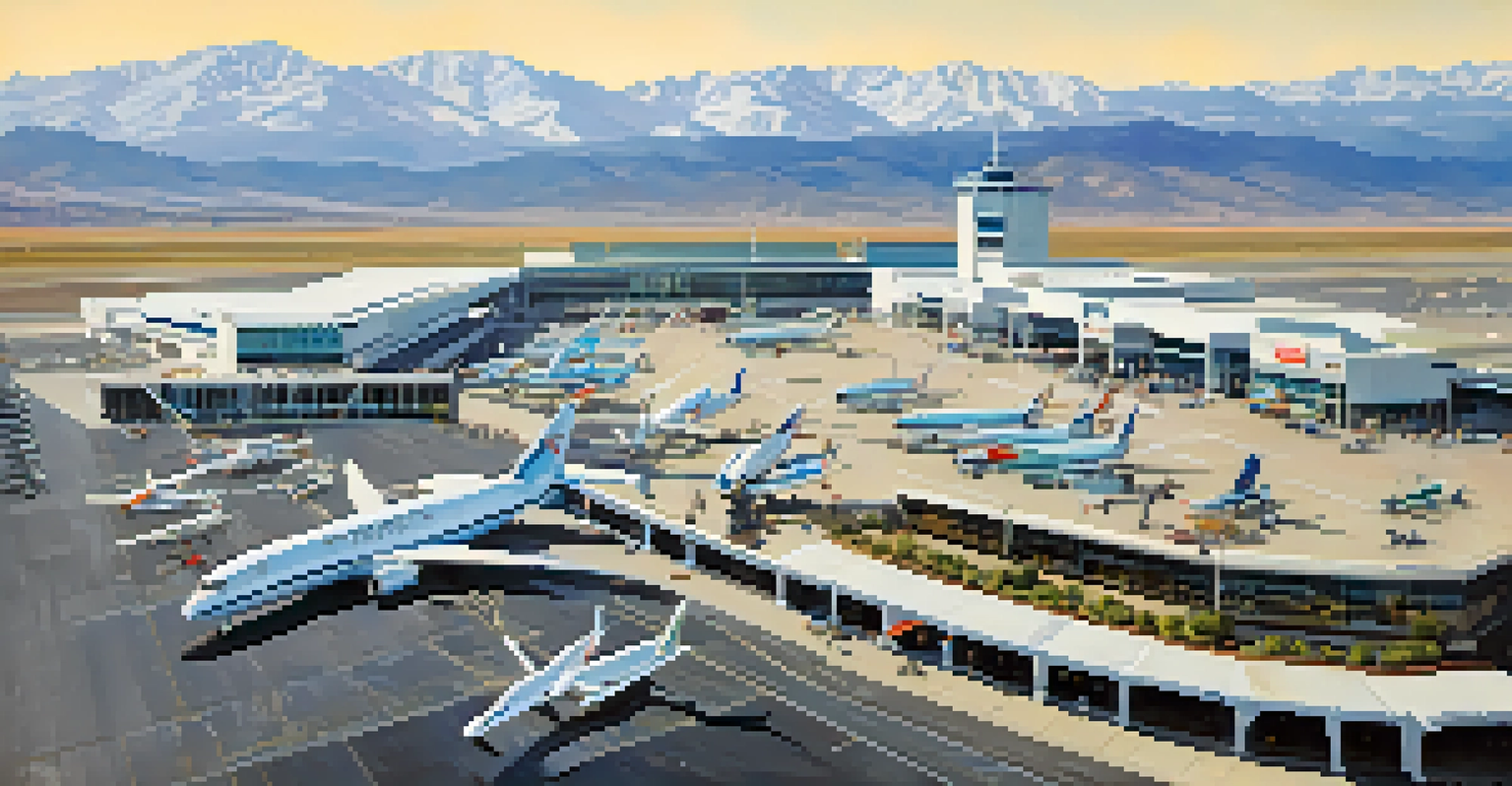Exploring Reno's Role as Northern Nevada's Transportation Hub

Reno's Strategic Location Boosts Connectivity
Reno sits at a critical junction where major highways converge, making it an ideal spot for transportation. With Interstate 80 running east to west and U.S. Route 395 heading north to south, the city's location allows for seamless travel across the region. This strategic positioning not only benefits local commuters but also attracts businesses that rely on efficient logistics.
Transportation is the backbone of any economy, connecting people and goods to markets and opportunities.
The city’s proximity to Lake Tahoe and other recreational areas enhances its appeal as a travel destination. As tourists flock to the region, the demand for reliable transportation options increases significantly. Reno's infrastructure is designed to accommodate this influx, ensuring that both visitors and residents have easy access to various destinations.
In essence, Reno’s location is more than just a point on the map; it’s a gateway that connects Northern Nevada to the rest of the country. This connectivity is a driving force behind the city’s growth and its role as a transportation hub, facilitating commerce and tourism alike.
Air Travel: Reno-Tahoe International Airport's Impact
Reno-Tahoe International Airport plays a pivotal role in the city’s transportation landscape. As the second busiest airport in Nevada, it serves as a major gateway for both domestic and international travelers. The airport connects Reno to key cities across the United States, making it an essential asset for business and tourism.

With several airlines offering various routes, travelers have the flexibility to reach their destinations with ease. This accessibility not only boosts tourism but also attracts companies looking to establish a presence in the region. The airport’s ongoing expansions and improvements further enhance its capability to serve Reno and its surrounding areas.
Reno: A Transportation Hub
Reno's strategic location at major highway intersections enhances its role as a vital transportation hub for both commerce and tourism.
Moreover, the airport's location allows for efficient ground transportation options, ensuring passengers can quickly reach their final destinations. This integrated approach to travel underscores Reno’s commitment to being a leading transportation hub in Northern Nevada.
Public Transit Options: Connecting the Community
Reno offers a range of public transit options that enhance mobility within the city and surrounding areas. The Regional Transportation Commission (RTC) operates a reliable bus system that connects neighborhoods, shopping centers, and major employment hubs. This system provides a cost-effective alternative for residents who prefer not to drive.
Good transportation means good business, and good business means a strong community.
In addition, the RTC has introduced a bike share program, encouraging eco-friendly transportation. This initiative not only promotes a healthier lifestyle but also reduces traffic congestion, allowing for a more sustainable approach to urban transit. By offering diverse transportation options, Reno ensures that everyone has access to essential services and amenities.
These public transit initiatives play a critical role in fostering community engagement and inclusivity. They create a more vibrant urban environment where residents can easily connect with one another, contributing to the city’s overall quality of life.
Rail Transportation: A Key Component of Reno's Network
Reno's rail transportation system is an integral part of its overall transportation infrastructure. The city is served by both freight and passenger rail services, which play a crucial role in moving goods and people efficiently. The Union Pacific Railroad, for instance, facilitates the transport of various commodities, linking Reno with major markets across the West.
Amtrak's California Zephyr provides passenger service, connecting Reno to cities like Sacramento and Chicago. This not only caters to tourists but also supports local residents who rely on rail for travel. The convenience of rail travel adds another layer to Reno’s transportation offerings, making it an attractive option for many.
Public Transit Enhances Mobility
The city's diverse public transit options, including buses and bike shares, promote accessibility and community engagement.
As the demand for sustainable transportation options grows, rail travel is becoming increasingly important. Reno's commitment to enhancing its rail services reflects a broader trend toward more environmentally friendly transport solutions, aligning with the city's vision for a sustainable future.
The Role of Highways in Local Economy and Growth
Highways have a significant impact on Reno’s economic development and growth. The extensive network of highways facilitates the movement of goods, making it easier for businesses to thrive. With access to major markets in California and beyond, local companies can expand their reach and drive economic success.
Moreover, the ease of transportation attracts new businesses to the area, further stimulating job creation and investment. As companies set up shop in Reno, they contribute to a vibrant economy that benefits residents through increased employment opportunities. This cycle of growth highlights the importance of a robust transportation network.
Reno’s leadership recognizes the need for ongoing investment in its highway infrastructure to support future growth. By enhancing roadways and promoting connectivity, the city is positioning itself as a prime location for businesses and residents alike.
Innovations in Transportation: Future Trends in Reno
Reno is not just resting on its laurels; it's actively exploring innovative transportation solutions. As technology continues to evolve, the city is looking into smart transportation systems that can streamline traffic flow and enhance safety. This includes the integration of real-time data to improve public transit and reduce congestion on the roads.
Electric vehicles (EVs) are also gaining traction in Reno, with more charging stations being installed throughout the city. This shift towards greener transportation options reflects a growing awareness of environmental issues and aligns with broader sustainability goals. The city is committed to promoting EV adoption, making it easier for residents to make eco-conscious choices.
Innovations Drive Future Growth
Reno's exploration of smart transportation systems and electric vehicle infrastructure reflects its commitment to sustainable and efficient transport solutions.
These innovations are just the beginning. As Reno embraces new technologies and sustainable practices, it is setting the stage for a transportation future that prioritizes efficiency, safety, and environmental responsibility.
Community Engagement in Transportation Planning
Community engagement is vital when it comes to transportation planning in Reno. The city actively seeks input from residents to understand their needs and preferences. By hosting public meetings and workshops, officials can gather valuable feedback that shapes transportation policies and initiatives.
This collaborative approach ensures that the transportation system reflects the community's values and priorities. When residents feel heard and involved, they are more likely to support new projects and initiatives. This sense of ownership fosters a stronger community connection, making people feel invested in their local environment.

Ultimately, successful transportation planning hinges on active participation from the community. Reno’s commitment to involving its residents in the decision-making process highlights the city’s dedication to creating a transportation system that truly serves its people.